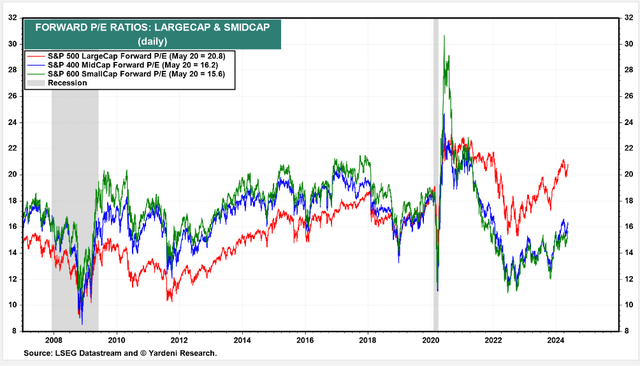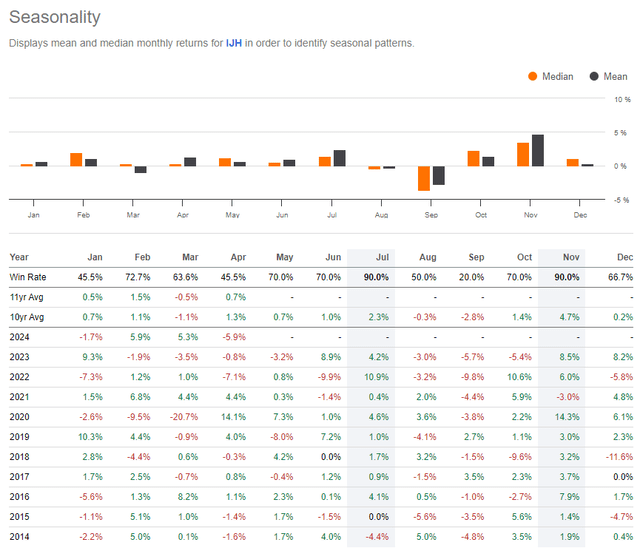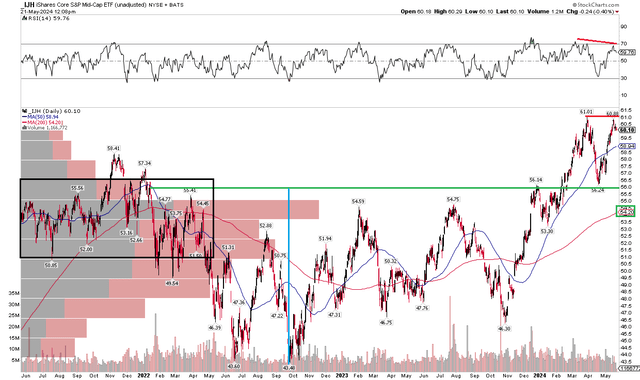Mid-caps are often the forgotten-about group of stocks in the US market. With so much focus on the Magnificent Seven leading the S&P 500 large-cap index to new all-time highs in the past year, as well as domestic small caps struggling to approach their late 2021 peak, mid-caps are usually relegated to an area of interest for only the most nimble asset allocators. But I see encouraging signs within the space.
I am upgrading the iShares Core S&P Mid-Cap ETF (NYSEARCA:IJH). With a price-to-earnings ratio of just 16, more than four turns cheaper than the SPX and barely more expensive than the S&P SmallCap 600, I see IJH as almost the best of both worlds. Long-term investors should also consider that mid-caps actually sport the best long-term returns among all three size profiles.
S&P MidCap 400 Forward P/E: Just 16, Much Cheaper vs 3 Years Ago

Yardeni
Mid-Caps Have Performed the Best Among the Three Size Groups

BofA Global Research
According to the issuer, IJH seeks to track the investment results of an index composed of mid-capitalization U.S. equities. The fund’s benchmark is the S&P MidCap 400 index. Being a low-cost and tax-efficient index ETF, it’s a solid choice for long-term investors aiming for exposure to diversify from large and small caps, which are typical traditional portfolio holdings.
IJH is a very large ETF, a common holding for investors seeking diversification in the US stock market. Its assets under management are now $85 billion, up from $63 billion when I last reviewed the ETF more than a year ago. With a very low 0.05% annual expense ratio and a small 1.3% dividend yield, the fund’s share-price momentum has improved in recent months, rising from a B ETF Grade by Seeking Alpha to an A- with all-time highs being tested as we approach the second half of the year.
Despite having significant cyclical exposure, the risk rating is strong while liquidity with IJH is very healthy – average daily volume is more than six million shares while its 30-day median bid/ask spread is narrow at a single basis point.
Looking closer at the portfolio, the 4-star, silver-rated ETF by Morningstar is spread across the bottom two rows of the style box with no major bent to either the value or growth style. As mentioned above, the low P/E ratio is solid in light of 10% long-term earnings growth. Be on the lookout for improved profit growth as 2024 wears on, too, as the Mag 7 stocks’ contribution to overall US EPS growth is expected to wane.
IJH: Portfolio & Factor Profiles

Morningstar
What can make IJH volatile is its relatively high exposure to the Industrials sector. Interestingly, the Industrials Select Sector SDPR ETF (XLI) has underperformed the S&P 500 since the start of the second quarter, so IJH has endured a bit of negative alpha lately.
But strength in Financials has been a general boon in the past six months. Of course, if the Information Technology sector continues to outperform, then IJH could sport more relative weakness.
IJH: Holdings & Dividend Information

Seeking Alpha
Turning to the calendar, returns on IJH have been strong now through July when analyzing trends over the past 10 years. Volatility often comes about toward the end of the third quarter, however.
IJH: Strong Returns Historically, May Through July

Seeking Alpha
The Technical Take
In March last year, I was cautious on IJH from a technical standpoint given where volatility levels were ranging. The fund indeed notched new lows the following October, undercutting levels from March 2023. Today, though, the technical picture looks brighter. Notice in the chart below that shares are above key support near the $56 mark, though a modest double-top feature is in play at $61. But with a rising long-term 200-day moving average – something that has been ongoing since early last year, the bulls appear to be in control of the primary trend.
Also take a look at the volume by price profile on the left side of the graph – there is a high amount of shares traded from the mid-$50s down to the upper $40s. That’s a high amount of potential buyers if we see a deeper pullback. But a key risk right now is slightly weaker RSI momentum today, so I would like to see a definitive thrust above the $61 resistance mark.
Overall, IJH looks much healthier than it did during much of last year, when a sideways trading pattern was transpiring.
IJH: Above the Important $56 Level, Monitoring Momentum Trends

StockCharts.com
The Bottom Line
I have a buy rating on IJH. I like its low-cost and decent diversification for non-large-cap US equity exposure. The valuation is almost as strong as it was a year ago, while its technical situation is more attractive despite underperforming the S&P 500 in the past 12 months.
Read the full article here
